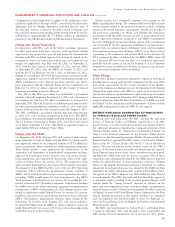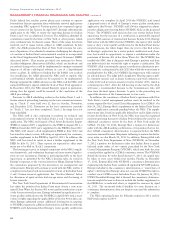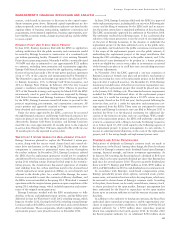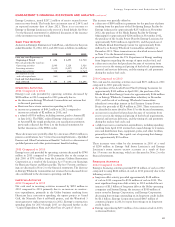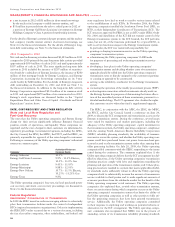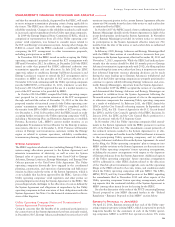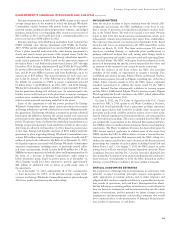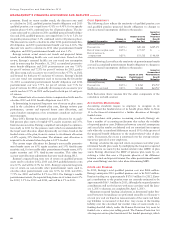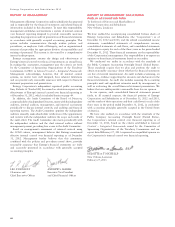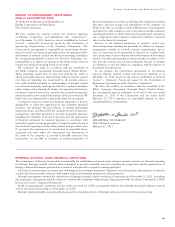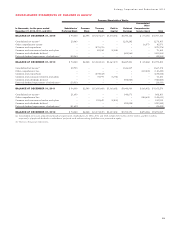Entergy 2012 Annual Report Download - page 43
Download and view the complete annual report
Please find page 43 of the 2012 Entergy annual report below. You can navigate through the pages in the report by either clicking on the pages listed below, or by using the keyword search tool below to find specific information within the annual report.Entergy Corporation and Subsidiaries 2012
MANAGEMENT’S FINANCIAL DISCUSSION AND ANALYSIS continued
Utility operating companies’ proposal to join MISO. In April 2012
the FERC conditionally accepted MISO’s proposal related to the allo-
cation of transmission upgrade costs in connection with the transi-
tion and integration of the Utility operating companies into MISO. In
November 2012 the FERC issued an order denying the requests for
rehearing of the April 2012 order, and conditionally accepting MISO’s
May 2012 compliance filing, subject to a further compliance filing due
within 30 days of the date of the November 2012 Order. In December
2012, MISO and the MISO Transmission Owners submitted to FERC
a request for rehearing and proposed revisions to the MISO Tariff
in compliance with FERC’s November 2012 order. The request for
rehearing and compliance filing are pending at FERC.
In addition, the Utility operating companies have proposed giving
authority to the E-RSC, upon unanimous vote and within the first
five years after the Utility operating companies join the MISO RTO,
(i) to require the Utility operating companies to file with the FERC a
proposed allocation of certain transmission upgrade costs among the
Utility operating companies’ transmission pricing zones that would
differ from the allocation that would occur under the MISO OATT
and (ii) to direct the Utility operating companies as transmission
owners to add projects to MISO’s transmission expansion plan. On
January 4, 2013, MISO submitted a filing with the FERC to give the
Organization of MISO States, Inc. enhanced authority for determin-
ing transmission cost allocation methodologies to be filed pursuant to
section 205 of the Federal Power Act.
On January 17, 2013, Occidental Chemical Corporation filed a
complaint against MISO and a petition for declaratory judgment,
both with the FERC, alleging that MISO’s proposed treatment of
Qualifying Facilities (QFs) in the Entergy region is unduly discrimi-
natory in violation of sections 205 and 206 of the Federal Power
Act and violates PURPA and the FERC’s implementing regulations.
Occidental’s filing asks that the FERC declare that MISO’s QF inte-
gration plan is unlawful, find that the plan cannot be implemented
because MISO did not file it pursuant to section 205 of the Federal
Power Act, and direct that MISO modify certain aspects of the plan.
On February 14, 2013, Entergy sought to intervene and filed an
answer to these pleadings. On January 22, 2013, the MPSC, APSC,
and City Council filed a petition for declaratory order with the FERC
requesting that the FERC determine whether the avoided cost cal-
culation methodology proposed in an LPSC proceeding by Entergy
Services, on behalf of Entergy Gulf States Louisiana and Entergy
Louisiana, complies with PURPA and the FERC’s implementing regu-
lations. On February 21, 2013, Entergy Services intervened and filed
an answer to the petition for declaratory order.
Entergy’s initial filings with its retail regulators estimated that
the transition and implementation costs of joining the MISO RTO
could be up to $105 million if all of the Utility operating compa-
nies join the MISO RTO, most of which will be spent in late 2012
and 2013. Maintaining the viability of the alternatives of Entergy
Arkansas joining the MISO RTO alone or standing alone within
an ICT arrangement is expected to result in an additional cost of
approximately $35 million, for a total estimated cost of up to $140
million. This amount could increase with extended litigation in vari-
ous regulatory proceedings. It is expected that costs will be incurred
to obtain regulatory approvals, to revise or implement commercial
and legal agreements, to integrate transmission and generation facili-
ties, to develop back-office accounting and settlement systems, and to
build out communications infrastructure.
FERC RELIABILITY STANDARDS INVESTIGATION
FERC’s Division of Investigations is conducting an investigation
of certain issues relating to the Utility operating compa-
nies compliance with certain reliability standards related to
protective system maintenance, facility ratings and modeling,
training, and communications. In November 2012 the FERC issued a
“Staff Notice of Alleged Violations” stating that the Division of
Investigations’ staff has preliminarily determined that Entergy
Services violated thirty-three requirements of sixteen reliability stan-
dards by failing to adequately perform certain functions. Entergy
Services is in the process of responding to the staff’s concerns. The
Energy Policy Act of 2005 provides authority to impose civil penalties
for violations of the Federal Power Act and FERC regulations.
U.S. DEPARTMENT OF JUSTICE INVESTIGATION
In September 2010, Entergy was notified that the U.S. Department of
Justice had commenced a civil investigation of competitive issues con-
cerning certain generation procurement, dispatch, and transmission
system practices and policies of the Utility operating companies. In
November 2012, the U.S. Department of Justice issued a press release
in which the U.S. Department of Justice stated, among other things,
that the civil investigation concerning certain generation procure-
ment, dispatch, and transmission system practices and policies of the
Utility operating companies would remain open. The release noted,
however, the intention of each of the Utility operating companies to
join MISO and Entergy’s agreement with ITC to undertake the spin-
off and merger of Entergy’s transmission business. The release stated
that if Entergy follows through on these matters, the U.S. Department
of Justice’s concerns will be resolved. The release further stated that
the U.S. Department of Justice will monitor developments, and in
the event that Entergy does not make meaningful progress, the U.S.
Department of Justice can and will take appropriate enforcement
action, if warranted.
MARKET AND CREDIT RISK SENSITIVE INSTRUMENTS
Market risk is the risk of changes in the value of commodity and
financial instruments, or in future net income or cash flows, in
response to changing market conditions. Entergy holds commodity
and financial instruments that are exposed to the following significant
market risks:
n The commodity price risk associated with the sale of electricity by
the Entergy Wholesale Commodities business.
n The interest rate and equity price risk associated with Entergy’s
investments in pension and other postretirement benefit trust
funds. See Note 11 to the financial statements for details regard-
ing Entergy’s pension and other postretirement benefit trust funds.
n The interest rate and equity price risk associated with Entergy’s
investments in nuclear plant decommissioning trust funds,
particularly in the Entergy Wholesale Commodities business.
See Note 17 to the financial statements for details regarding
Entergy’s decommissioning trust funds.
n The interest rate risk associated with changes in interest rates
as a result of Entergy’s issuances of debt. Entergy manages its
interest rate exposure by monitoring current interest rates and
its debt outstanding in relation to total capitalization. See
Notes 4 and 5 to the financial statements for the details of
Entergy’s debt outstanding.
The Utility business has limited exposure to the effects of market risk
because it operates primarily under cost-based rate regulation. To
the extent approved by their retail rate regulators, the Utility operat-
ing companies hedge the exposure to natural gas price volatility of
their fuel and gas purchased for resale costs, which are recovered
from customers.
Entergy’s commodity and financial instruments are exposed to
credit risk. Credit risk is the risk of loss from nonperformance by sup-
pliers, customers, or financial counterparties to a contract or agree-
ment. Entergy is also exposed to a potential demand on liquidity due
to credit support requirements within its supply or sales agreements.
41


